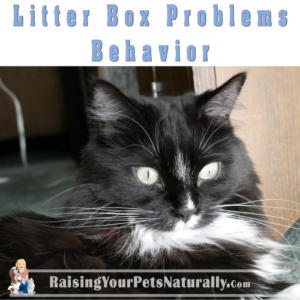Google Adsense—>

Is Your Cat Not Using The Litter Box?
Cat Not Using Litter Box, Why is My Cat Not Using The Litter Box | Behavioral Reasons and Solutions

Medical Reasons For Not Using A Litter Box (read first).
Now that you have addressed your cat’s medical conditions and diet, it’s time to talk about behavioral solutions. We’ll take this step by step, discussing a variety of common problems and their possible solutions.
It’s important to understand that not every cat fits neatly into one problem and solution. When going through the suggestions below, try a few at a time. Try 2 different types of litter boxes, a variety of cat litter types, and different locations. See if your cat will help guide you on your choices. Finding the right solution may take some time and effort. But that’s OK. Responsible cat owners are responsible for our cats, including their behavior.
Cat Litter Box: For some cats, finding the right litter box is key. If your cat is having litter box problems, I would suggest looking for a large cat litter box that is low to the ground and not too hard to get into. A plastic storage bin may work well. If that is still too high, look into a large plastic serving tray. A lot of cats do not like covered litter boxes or cat liners. Don’t use automatic litter boxes, the noise and movement can be scary for cats. And personally, I do not think they are very sanitary.
Lots of Cat Litter Boxes: Make using a clean litter box easy for your cat. At a minimum, you should have 1 more litter box than you do cats. So, if you have 3 cats, you should have at least 4 boxes. Also, at least one box on every floor your cat visits.
Cat Litter Choice: Cats sometimes come pre-programmed for a litter preference. If you recently adopted your cat, what kind of litter did the shelter have? Or was he a stray? Maybe you should start with organic dirt or sod, then add your litter choice bit by bit. If your cat has used a clay or silica gel litter in the past, I would highly recommend working on transitioning him to a non-toxic litter once his potty habits are back on track. You can read my article Non-Toxic Cat Litter: Is Your Cat’s Litter Safe? for safe choices. Play around with litter depth between 2-4” of clean litter.
Location, Location, Location: Have you ever had to use a public restroom? Were you a little stressed at who might hear you? Did you feel a little uneasy, uncomfortable or rushed? Your cat’s litter box should be easily accessible and in a quiet and safe location. Do not place your cat’s litter box in a location that is noisy, or where another pet can ambush him. He should have easy access to the opening and a pleasant and relaxing experience. You may try placing your cat’s litter box around locations he has chosen to eliminate on in the past. Also, maybe try a different location than the box was previously.
Food Bowl and Water: I’m going to guess you don’t eat your dinner next to your toilet. Please keep cat’s food and water in a separate location. Your cat is going to eat, so he may choose to eliminate elsewhere.
Cleanliness: This is a must! Put yourself in your cat’s paws. He is WALKING on the litter. Then he cleans his paws by licking them. Is he walking on old urine and feces? Would you? If you are dealing with cat litter box problems, scoop about 5 minutes after your cat has eliminated in the box. Cleanliness also means regularly replacing the cat litter and even scrubbing the actual litter box.
Previous Potty Spots: If your cat has eliminated outside of his box, clean the spots thoroughly with an enzymatic cleaner, then spray the location with Feliway, a synthetic pheromone product that discourages marking and elimination. Then cover the spots with something to prevent future use. A simple box or even a plastic carpet runner covered in sticky tape can deter a cat from going there again.
Stress or Conflict: If your cat is generally high-stress, or you see a conflict between other family members, you should address his needs and learn how to build up your cat’s confidence and address the conflict. This is along the same lines as addressing any medical issues. If this is the case, I do offer behavioral assistance.
It’s important to remember, when your cat stops using his litter box, there is a reason. Something is disrupting his emotions, environment, territory or his physical body, and those reasons must be addressed. I hope you find a solution for your cat’s litter box issues, and remember, if you need help, seek your veterinarian or a specialist working with cat behavior.
Your questions or comments are welcome below.
Are you looking for even more ways to stay up to date with Raising Your Pets Naturally? Sign up for the newsletter for more tips and promotions. Don’t forget to be social and Like, Follow and Subscribe. Comments below are always welcome.
Facebook Twitter Pinterest Instagram YouTube
 |
 |
  |
  |




This is a great resource for cat parents. I definitely agree that therebisba reason behind any unusual behavior with cats and their litter boxes. When I had cats, I always made sure they had different varieties of boxes to use and one box for each cat, plus 1 extra!
Thanks, Jane. Their potty habits (dogs too) really do tell us a lot if we can figure it out.
I am still amazed at the cat products today compared to 30 years ago – love reading, learning and wondering hmmm whether I will get another cat or not
hahaha Kitties are nice…:)
Clean litter boxes are a must! I hear too that sometimes the self cleaning ones scare cats.
Yes. And they are so dirty. I was a pet sitter in my former life and they always broke and were nasty. I had scared kitties too.
Thanks for this thorough assessment of the problems and great suggestions on how to deal with them.
Sure thing. I try to be thorough and offer a variety of solutions.
Great advice! I could always tell when my cat Maggie felt the litter box simply wasn’t sufficiently clean, she’d poop right outside it, LOL!
Love & biscuits,
Dogs Luv Us and We Luv Them
Thank you. Yes, kind of gross walking on pee and poo.